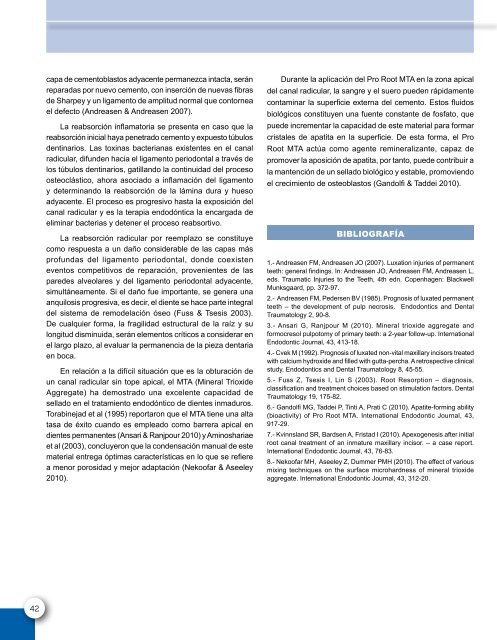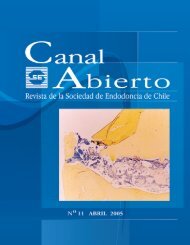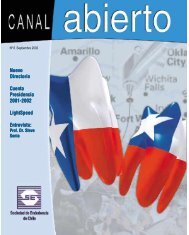Revista de la Sociedad de Endodoncia de Chile Nº 23 Abril 2011
Revista de la Sociedad de Endodoncia de Chile Nº 23 Abril 2011
Revista de la Sociedad de Endodoncia de Chile Nº 23 Abril 2011
You also want an ePaper? Increase the reach of your titles
YUMPU automatically turns print PDFs into web optimized ePapers that Google loves.
42<br />
capa <strong>de</strong> cementob<strong>la</strong>stos adyacente permanezca intacta, serán<br />
reparadas por nuevo cemento, con inserción <strong>de</strong> nuevas fibras<br />
<strong>de</strong> Sharpey y un ligamento <strong>de</strong> amplitud normal que contornea<br />
el <strong>de</strong>fecto (Andreasen & Andreasen 2007).<br />
La reabsorción inf<strong>la</strong>matoria se presenta en caso que <strong>la</strong><br />
reabsorción inicial haya penetrado cemento y expuesto túbulos<br />
<strong>de</strong>ntinarios. Las toxinas bacterianas existentes en el canal<br />
radicu<strong>la</strong>r, difun<strong>de</strong>n hacia el ligamento periodontal a través <strong>de</strong><br />
los túbulos <strong>de</strong>ntinarios, gatil<strong>la</strong>ndo <strong>la</strong> continuidad <strong>de</strong>l proceso<br />
osteoclástico, ahora asociado a inf<strong>la</strong>mación <strong>de</strong>l ligamento<br />
y <strong>de</strong>terminando <strong>la</strong> reabsorción <strong>de</strong> <strong>la</strong> lámina dura y hueso<br />
adyacente. El proceso es progresivo hasta <strong>la</strong> exposición <strong>de</strong>l<br />
canal radicu<strong>la</strong>r y es <strong>la</strong> terapia endodóntica <strong>la</strong> encargada <strong>de</strong><br />
eliminar bacterias y <strong>de</strong>tener el proceso reabsortivo.<br />
La reabsorción radicu<strong>la</strong>r por reemp<strong>la</strong>zo se constituye<br />
como respuesta a un daño consi<strong>de</strong>rable <strong>de</strong> <strong>la</strong>s capas más<br />
profundas <strong>de</strong>l ligamento periodontal, don<strong>de</strong> coexisten<br />
eventos competitivos <strong>de</strong> reparación, provenientes <strong>de</strong> <strong>la</strong>s<br />
pare<strong>de</strong>s alveo<strong>la</strong>res y <strong>de</strong>l ligamento periodontal adyacente,<br />
simultáneamente. Si el daño fue importante, se genera una<br />
anquilosis progresiva, es <strong>de</strong>cir, el diente se hace parte integral<br />
<strong>de</strong>l sistema <strong>de</strong> remo<strong>de</strong><strong>la</strong>ción óseo (Fuss & Tsesis 2003).<br />
De cualquier forma, <strong>la</strong> fragilidad estructural <strong>de</strong> <strong>la</strong> raíz y su<br />
longitud disminuida, serán elementos críticos a consi<strong>de</strong>rar en<br />
el <strong>la</strong>rgo p<strong>la</strong>zo, al evaluar <strong>la</strong> permanencia <strong>de</strong> <strong>la</strong> pieza <strong>de</strong>ntaria<br />
en boca.<br />
En re<strong>la</strong>ción a <strong>la</strong> difícil situación que es <strong>la</strong> obturación <strong>de</strong><br />
un canal radicu<strong>la</strong>r sin tope apical, el MTA (Mineral Trioxi<strong>de</strong><br />
Aggregate) ha <strong>de</strong>mostrado una excelente capacidad <strong>de</strong><br />
sel<strong>la</strong>do en el tratamiento endodóntico <strong>de</strong> dientes inmaduros.<br />
Torabinejad et al (1995) reportaron que el MTA tiene una alta<br />
tasa <strong>de</strong> éxito cuando es empleado como barrera apical en<br />
dientes permanentes (Ansari & Ranjpour 2010) y Aminoshariae<br />
et al (2003), concluyeron que <strong>la</strong> con<strong>de</strong>nsación manual <strong>de</strong> este<br />
material entrega óptimas características en lo que se refiere<br />
a menor porosidad y mejor adaptación (Nekoofar & Aseeley<br />
2010).<br />
Durante <strong>la</strong> aplicación <strong>de</strong>l Pro Root MTA en <strong>la</strong> zona apical<br />
<strong>de</strong>l canal radicu<strong>la</strong>r, <strong>la</strong> sangre y el suero pue<strong>de</strong>n rápidamente<br />
contaminar <strong>la</strong> superficie externa <strong>de</strong>l cemento. Estos fluidos<br />
biológicos constituyen una fuente constante <strong>de</strong> fosfato, que<br />
pue<strong>de</strong> incrementar <strong>la</strong> capacidad <strong>de</strong> este material para formar<br />
cristales <strong>de</strong> apatita en <strong>la</strong> superficie. De esta forma, el Pro<br />
Root MTA actúa como agente remineralizante, capaz <strong>de</strong><br />
promover <strong>la</strong> aposición <strong>de</strong> apatita, por tanto, pue<strong>de</strong> contribuir a<br />
<strong>la</strong> mantención <strong>de</strong> un sel<strong>la</strong>do biológico y estable, promoviendo<br />
el crecimiento <strong>de</strong> osteob<strong>la</strong>stos (Gandolfi & Tad<strong>de</strong>i 2010).<br />
BIBLIOGRAFÍA<br />
1.- Andreasen FM, Andreasen JO (2007). Luxation injuries of permanent<br />
teeth: general findings. In: Andreasen JO, Andreasen FM, Andreasen L,<br />
eds. Traumatic Injuries to the Teeth, 4th edn. Copenhagen: B<strong>la</strong>ckwell<br />
Munksgaard, pp. 372-97.<br />
2.- Andreasen FM, Pe<strong>de</strong>rsen BV (1985). Prognosis of luxated permanent<br />
teeth – the <strong>de</strong>velopment of pulp necrosis. Endodontics and Dental<br />
Traumatology 2, 90-8.<br />
3.- Ansari G, Ranjpour M (2010). Mineral trioxi<strong>de</strong> aggregate and<br />
formocresol pulpotomy of primary teeth: a 2-year follow-up. International<br />
Endodontic Journal, 43, 413-18.<br />
4.- Cvek M (1992). Prognosis of luxated non-vital maxil<strong>la</strong>ry incisors treated<br />
with calcium hydroxi<strong>de</strong> and filled with gutta-percha. A retrospective clinical<br />
study. Endodontics and Dental Traumatology 8, 45-55.<br />
5.- Fuss Z, Tsesis I, Lin S (2003). Root Resorption – diagnosis,<br />
c<strong>la</strong>ssification and treatment choices based on stimu<strong>la</strong>tion factors. Dental<br />
Traumatology 19, 175-82.<br />
6.- Gandolfi MG, Tad<strong>de</strong>i P, Tinti A, Prati C (2010). Apatite-forming ability<br />
(bioactivity) of Pro Root MTA. International Endodontic Journal, 43,<br />
917-29.<br />
7.- Kvinns<strong>la</strong>nd SR, Bardsen A, Fristad I (2010). Apexogenesis after initial<br />
root canal treatment of an inmature maxil<strong>la</strong>ry incisor. – a case report.<br />
International Endodontic Journal, 43, 76-83.<br />
8.- Nekoofar MH, Aseeley Z, Dummer PMH (2010). The effect of various<br />
mixing techniques on the surface microhardness of mineral trioxi<strong>de</strong><br />
aggregate. International Endodontic Journal, 43, 312-20.





